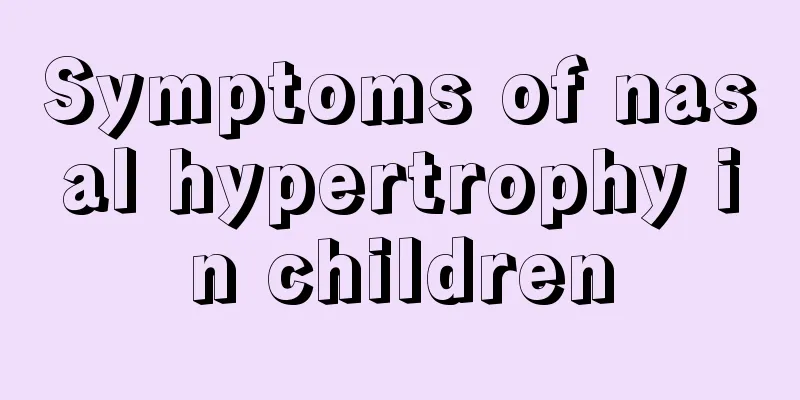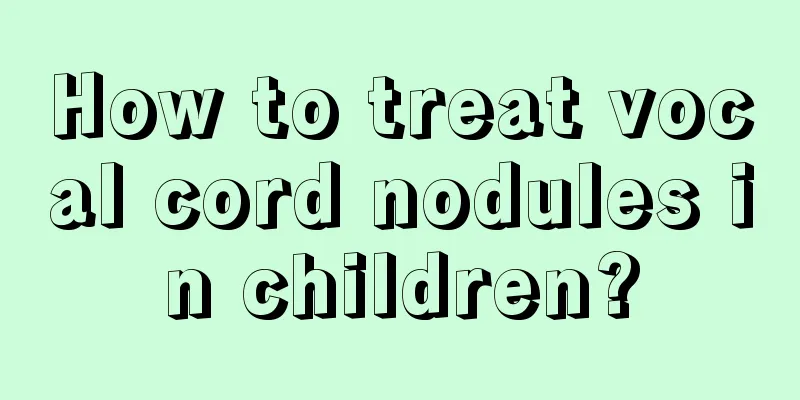Symptoms of nasal hypertrophy in children

|
Children’s health is the most important issue for parents, because children are young and if they get sick, it will affect their health throughout their lives. Therefore, once a child is found to be ill when he is young, he should be treated promptly to prevent the disease from developing into a chronic condition. Hypertrophy of the body in children is a common disease phenomenon, and some children now also suffer from hypertrophy of the nasal concha. So what are the symptoms of enlarged nasal concha in children? 1. Typical symptoms of nasal concha hypertrophy in children Systemic manifestations, often with systemic nutritional and developmental disorders, are mainly manifested as chronic poisoning reflex neurological manifestations, such as dull expression, chest tightness and uneasiness, poor lung expansion, which may lead to pigeon chest or flat chest over time. A small number of people may develop cor pulmonale and even acute heart failure due to chronic nasal obstruction and long-term hypoxia. 2. What is nasal concha hypertrophy in children? Turbinate hypertrophy is a common chronic nasal disease. With its increasing incidence, the disease is now becoming younger and younger, and children have become the main sufferers of turbinate hypertrophy. Turbinate hypertrophy refers to the long-term influence of inflammation on the nasal concha, which causes edema of the turbinate mucosa, resulting in nasal obstruction and great damage, and may even lead to serious complications such as emphysema, cor pulmonale, and asthma. The symptoms include open-mouth breathing during sleep, snoring with the tongue root falling back, restless sleep at night, frequent nasal discharge, occlusive nasal sounds when speaking, and slurred speech. Due to long-term mouth breathing, the development of facial bones is hindered. , 3. The harm of hypertrophy of nasal concha in children Children may experience otorhinolaryngitis and other symptoms due to obstruction of the posterior nasal cavity and the pharyngeal opening of the Eustachian tube by enlarged adenoids. The maxillary bone becomes longer, the hard palate is high and arched, the dentition is irregular, the upper incisors are exposed, the lips are thick, the face lacks expression, and there is a dazed look, forming an "adenoid face". There is a movement disorder between swallowing and breathing, choking and coughing often occur, the excrement affects the respiratory mucosa, and it is easy to suffer from bronchitis. Obstruction of the Eustachian tube can easily lead to non-suppurative otitis media, resulting in reduced suction and retraction of the tympanic membrane. When turbinate hypertrophy affects the physiological function of the nasal cavity, breathing problems will occur, causing a decrease in blood oxygen concentration, affecting the function and metabolism of other tissues and organs, and causing symptoms such as headache, dizziness, memory loss, chest pain, chest tightness, and mental atrophy. Therefore, it is important to correctly understand the manifestations of turbinate hypertrophy so that the disease can be discovered early, checked early, and treated in time. |
<<: What are the symptoms of baby's stomach change?
>>: Symptoms of blocked tear sac in baby
Recommend
What is the best mosquito repellent for babies?
Summer is the season when mosquitoes and flies ar...
How to treat rhinitis in children?
In daily life, patients with rhinitis often do no...
Symptoms of otitis media in children
It is quite common for children to suffer from ot...
Can children eat honey?
Honey is not only a delicacy that adults like, bu...
How to prevent tooth decay in babies
Tooth decay is a common symptom for us. Although ...
What are the massage techniques for children with colds?
As babies grow up, it is inevitable that they wil...
Treatment for newborns who refuse to eat or drink
As parents, when our children refuse to eat or dr...
How to develop children's intelligence
How to develop children's intelligence well i...
What should I do if my child suffers from recurrent constipation?
I believe everyone is familiar with the word cons...
How much milk does a 2-year-old baby need in a day
As the baby continues to grow, the amount of milk...
What are the treatments for ADHD in children?
Nowadays, most families have a child who loves to...
Is it normal for a child to have vision of 49? What is the normal vision of a 5-year-old child?
When children reach a certain age, parents will p...
What diseases are related to the baby's constant nasal congestion?
Many parents have reported that their children al...
What to do if your child has constipation
Constipation is a common problem that everyone wi...
Why does my one month old baby cough?
Now many parents have reported that their childre...









